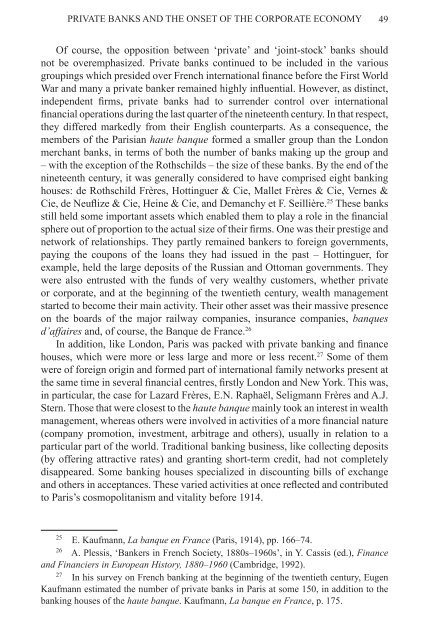the world of private banking
the world of private banking
the world of private banking
Create successful ePaper yourself
Turn your PDF publications into a flip-book with our unique Google optimized e-Paper software.
PRIVAtE BANKS AND tHE ONSEt OF tHE CORpORAtE EcONOmy 49<br />
Of course, <strong>the</strong> opposition between ‘<strong>private</strong>’ and ‘joint-stock’ banks should<br />
not be overemphasized. Private banks continued to be included in <strong>the</strong> various<br />
groupings which presided over French international finance before <strong>the</strong> First World<br />
War and many a <strong>private</strong> banker remained highly influential. However, as distinct,<br />
independent firms, <strong>private</strong> banks had to surrender control over international<br />
financial operations during <strong>the</strong> last quarter <strong>of</strong> <strong>the</strong> nineteenth century. In that respect,<br />
<strong>the</strong>y differed markedly from <strong>the</strong>ir English counterparts. As a consequence, <strong>the</strong><br />
members <strong>of</strong> <strong>the</strong> Parisian haute banque formed a smaller group than <strong>the</strong> London<br />
merchant banks, in terms <strong>of</strong> both <strong>the</strong> number <strong>of</strong> banks making up <strong>the</strong> group and<br />
– with <strong>the</strong> exception <strong>of</strong> <strong>the</strong> Rothschilds – <strong>the</strong> size <strong>of</strong> <strong>the</strong>se banks. By <strong>the</strong> end <strong>of</strong> <strong>the</strong><br />
nineteenth century, it was generally considered to have comprised eight <strong>banking</strong><br />
houses: de Rothschild Frères, Hottinguer & Cie, Mallet Frères & Cie, Vernes &<br />
Cie, de Neuflize & Cie, Heine & Cie, and Demanchy et F. Seillière. 25 These banks<br />
still held some important assets which enabled <strong>the</strong>m to play a role in <strong>the</strong> financial<br />
sphere out <strong>of</strong> proportion to <strong>the</strong> actual size <strong>of</strong> <strong>the</strong>ir firms. One was <strong>the</strong>ir prestige and<br />
network <strong>of</strong> relationships. They partly remained bankers to foreign governments,<br />
paying <strong>the</strong> coupons <strong>of</strong> <strong>the</strong> loans <strong>the</strong>y had issued in <strong>the</strong> past – Hottinguer, for<br />
example, held <strong>the</strong> large deposits <strong>of</strong> <strong>the</strong> Russian and Ottoman governments. They<br />
were also entrusted with <strong>the</strong> funds <strong>of</strong> very wealthy customers, whe<strong>the</strong>r <strong>private</strong><br />
or corporate, and at <strong>the</strong> beginning <strong>of</strong> <strong>the</strong> twentieth century, wealth management<br />
started to become <strong>the</strong>ir main activity. Their o<strong>the</strong>r asset was <strong>the</strong>ir massive presence<br />
on <strong>the</strong> boards <strong>of</strong> <strong>the</strong> major railway companies, insurance companies, banques<br />
d’affaires and, <strong>of</strong> course, <strong>the</strong> Banque de France. 26<br />
In addition, like London, Paris was packed with <strong>private</strong> <strong>banking</strong> and finance<br />
houses, which were more or less large and more or less recent. 27 Some <strong>of</strong> <strong>the</strong>m<br />
were <strong>of</strong> foreign origin and formed part <strong>of</strong> international family networks present at<br />
<strong>the</strong> same time in several financial centres, firstly London and New York. This was,<br />
in particular, <strong>the</strong> case for Lazard Frères, E.N. Raphaël, Seligmann Frères and A.J.<br />
Stern. Those that were closest to <strong>the</strong> haute banque mainly took an interest in wealth<br />
management, whereas o<strong>the</strong>rs were involved in activities <strong>of</strong> a more financial nature<br />
(company promotion, investment, arbitrage and o<strong>the</strong>rs), usually in relation to a<br />
particular part <strong>of</strong> <strong>the</strong> <strong>world</strong>. Traditional <strong>banking</strong> business, like collecting deposits<br />
(by <strong>of</strong>fering attractive rates) and granting short-term credit, had not completely<br />
disappeared. Some <strong>banking</strong> houses specialized in discounting bills <strong>of</strong> exchange<br />
and o<strong>the</strong>rs in acceptances. These varied activities at once reflected and contributed<br />
to Paris’s cosmopolitanism and vitality before 1914.<br />
25<br />
E. Kaufmann, La banque en France (Paris, 1914), pp. 166–74.<br />
26<br />
A. Plessis, ‘Bankers in French Society, 1880s–1960s’, in Y. Cassis (ed.), Finance<br />
and Financiers in European History, 1880–1960 (Cambridge, 1992).<br />
27<br />
In his survey on French <strong>banking</strong> at <strong>the</strong> beginning <strong>of</strong> <strong>the</strong> twentieth century, Eugen<br />
Kaufmann estimated <strong>the</strong> number <strong>of</strong> <strong>private</strong> banks in Paris at some 150, in addition to <strong>the</strong><br />
<strong>banking</strong> houses <strong>of</strong> <strong>the</strong> haute banque. Kaufmann, La banque en France, p. 175.












![[Pham_Sherisse]_Frommer's_Southeast_Asia(Book4You)](https://img.yumpu.com/38206466/1/166x260/pham-sherisse-frommers-southeast-asiabook4you.jpg?quality=85)



